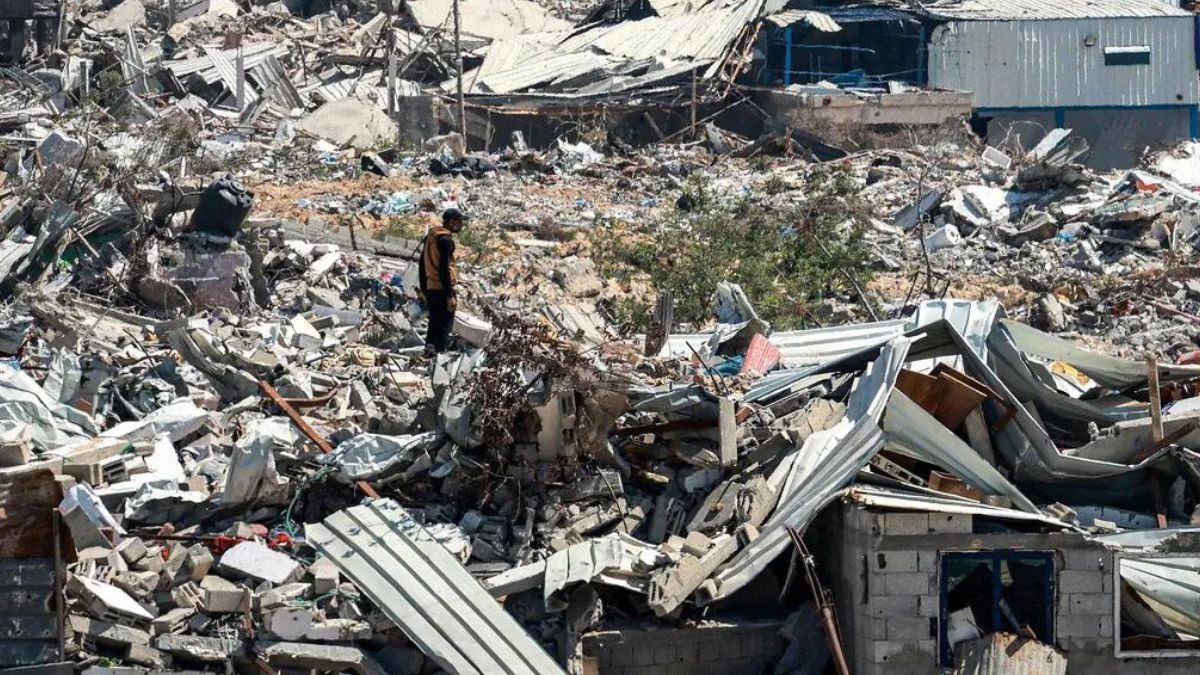Israel withdrew its ground forces from the southern Gaza Strip on Sunday, marking a partial withdrawal six months into the catastrophic war that began with the October 7 attacks.
However, the military declared that a “significant force” would continue to operate elsewhere in the besieged Palestinian territory, able “to conduct precise intelligence based operations.” Israel’s prime minister, Benjamin Netanyahu, declared that his country was “just one step away from victory” and that war would not stop until Hamas released all hostages.
He informed his cabinet that “there will be no ceasefire without the return of hostages” just before new truce negotiations were scheduled to begin in Cairo. It simply won’t occur."
The statement “Israel is ready for a deal, Israel is not ready to surrender” was emphasized by Netanyahu.
Witnesses reported that during the night, airstrikes continued to bombard Khan Yunis and Rafah.
The army claimed that after months of combat, it withdrew its soldiers from southern Gaza, leaving the Hamas commander Yahya Sinwar’s hometown of Khan Yunis in ruins.
“The 98th commando division has concluded its mission in Khan Yunis,” the army told AFP. “The division left the Gaza Strip in order to recuperate and prepare for future operations.”
Impact Shorts
More ShortsAn army official told the Haaretz daily that the troops pulled out after they had “dismantled Hamas’s Khan Yunis brigades and killed thousands of its members.
“We did everything we could there.”
The news of the partial withdrawal came on the day talks towards a truce and hostage release deal were expected to resume in Cairo, including US, Qatari and Egyptian mediators.
CIA chief Bill Burns and Qatari Prime Minister Sheikh Mohammed bin Abdulrahman bin Jassim Al-Thani will join Egyptian officials for indirect talks from Sunday between the Israeli and Hamas delegations, Egypt’s Al-Qahera News said.
Netanyahu had long threatened a ground offensive on far-southern Gaza’s Rafah city, sparking global concern, including from Israel’s top ally the United States.
Up to 1.5 million Palestinians are crowded into the area on the Egyptian border, many living in tents. Dozens left Rafah by foot, in cars and on donkey carts and returned to Khan Yunis on Sunday after the Israeli pullout, AFP images showed.
On Thursday, US President Joe Biden – angered by an Israeli strike that killed seven aid workers of a US-based food charity – told Netanyahu he wants to see a ceasefire and hostage release deal and ramped-up aid deliveries.
Biden – whose government is Israel’s top arms supplier and political backer – also hinted at making US support for Israel conditional on curtailing the killing of civilians and improving humanitarian conditions.
Several aid trucks on Sunday entered southern Gaza through the Rafah crossing with Egypt, the drivers honking their horns as crowds ran after them, AFP TV footage showed.
Israel has faced a storm of international outrage over the killing of seven aid workers of the US-based food charity World Central Kitchen in a Gaza air strike on April 1.
British Prime Minister Rishi Sunak has also demanded that “this terrible conflict must end”.
A Palestinian father-of-six in northern Gaza, Muhammad Yunis, 51, told AFP the territory’s 2.4 million people desperately need a reprieve from the bombardment and suffering.
“It’s been half a year and the bombing and starvation continue,” said the man from Beit Lahia, now a broken landscape of shattered buildings.
“Watching the thin bodies of our children takes away our souls … I feel helpless and humiliated,” he said.
“Isn’t the bombing, death and destruction enough? There are bodies still under the rubble. We can smell the stench.”
UNICEF chief Catherine Russell pointed out that more than 13,000 children were reportedly among those killed.
“Homes, schools and hospitals in ruin. Teachers, doctors and humanitarians killed. Famine is imminent,” she said on X, formerly Twitter, on Saturday.
“The level and speed of destruction are shocking. Children need a ceasefire NOW.”
The Gaza war broke out on October 7 with an unprecedented attack by Hamas militants that resulted in the deaths of 1,170 people, mostly civilians.
Hamas and Islamic Jihad militants also took more than 250 hostages, and 129 remain in Gaza, including 34 who the army says are dead.
Israel’s retaliatory offensive has killed at least 33,175 people in Gaza, mostly women and children, according to the health ministry in the Hamas-run territory.
Vast areas of Gaza have been turned into a rubble-strewn wasteland, its people trapped in a dire humanitarian crisis amid an Israeli military onslaught.
Gaza has received only sporadic aid via a road crossing with Egypt, airdrops and two sea shipments – and aid agencies warn the deliveries fall far short of the dire needs.
Under US pressure, Israel has pledged to allow for the first time aid deliveries through its Erez border crossing with northern Gaza.
Most of Gaza’s hospitals are out of action and the largest, Al-Shifa, is “now an empty shell with human graves”, said World Health Organization head Tedros Adhanom Ghebreyesus.
Netanyahu has meanwhile come under intense pressure at home from families and supporters of hostages, and from a resurgent anti-government protest movement.
Ten of thousands rallied in Tel Aviv and other cities Saturday, demanding “elections now”.
Among the protesters was Israel’s centrist opposition leader Yair Lapid, who was later headed to Washington, his Yesh Atid party said.
Lapid was expected to meet US Secretary of State Antony Blinken, National Security Advisor Jake Sullivan and Senate Majority Leader Chuck Schumer, a fierce critic of Netanyahu.
Fears that the war could spread have intensified after Iran vowed retaliation for the killing of seven Revolutionary Guards in an air strike last Monday on the consular annex of its embassy in Damascus.
Yahya Rahim Safavi, senior adviser to Iran’s supreme leader Ayatollah Ali Khamenei, was quoted as saying by the ISNA news agency that “the embassies of the Zionist regime are no longer safe”.
)